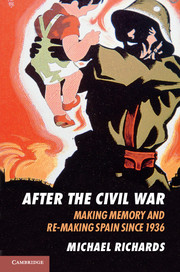Book contents
- Frontmatter
- Contents
- List of maps and tables
- Preface
- Acknowledgements
- Maps
- Introduction: cultural trauma in Spain
- Part I Setting the scene
- Part II Memories of war during the Franco years
- 3 Repression and remembrance: the victors’ liturgy of memory
- 4 Repression and reproduction: social memory in the 1940s
- 5 Memory and politics: from civil war to Cold War
- 6 Memory and migration: flight from the countryside in the 1950s
- 7 Commemorating ‘Franco's peace’: the 25th anniversary of the Victory
- 8 Contesting ‘Franco's peace’: transformation from below in the 1960s
- 9 Transition and reconciliation: politics and the Church in the 1970s
- Part III Memories of war after Franco
- Conclusion: the history of war memories in Spain
- Glossary and abbreviations
- Sources and select bibliography
- Index
- References
4 - Repression and reproduction: social memory in the 1940s
Published online by Cambridge University Press: 05 June 2013
- Frontmatter
- Contents
- List of maps and tables
- Preface
- Acknowledgements
- Maps
- Introduction: cultural trauma in Spain
- Part I Setting the scene
- Part II Memories of war during the Franco years
- 3 Repression and remembrance: the victors’ liturgy of memory
- 4 Repression and reproduction: social memory in the 1940s
- 5 Memory and politics: from civil war to Cold War
- 6 Memory and migration: flight from the countryside in the 1950s
- 7 Commemorating ‘Franco's peace’: the 25th anniversary of the Victory
- 8 Contesting ‘Franco's peace’: transformation from below in the 1960s
- 9 Transition and reconciliation: politics and the Church in the 1970s
- Part III Memories of war after Franco
- Conclusion: the history of war memories in Spain
- Glossary and abbreviations
- Sources and select bibliography
- Index
- References
Summary
If all this bloodshed is washed away and forgotten it will be not only a triumph for General Franco but a miracle.
Times are bad; we are living among people any one of whom may have murdered our father or our brother, and yet we have to treat them as if they were our friends.
That the immediate post-war years in Spain were marked by social fragmentation should not seem surprising. Even from the cloistered surroundings of Salamanca, Franco's temporary headquarters in 1937, the Rector of the Irish seminary recognised that the horror would not be easily forgotten. A year later he had not altered his view: ‘those [who] remember our tiny civil war in Ireland, and what it cost the country, will understand what the recent war must have cost Spain’. When, a decade later, in the spring of 1949 Gerald Brenan called on a family in rural Granada he had first known years before the war he found that the horrors of the executions which had followed the military rising of 1936 were as present in their minds ‘as though they had happened yesterday’. Perhaps they felt able to talk about the war to someone who was an outsider, as had the officer of the Civil Guard cited above, more sensitive than most to fears about an ‘enemy within’.
Appalled by the violence on both sides, the wartime President of the Second Republic, Manuel Azaña, had made an impassioned plea in July 1938 for a future reconciliation, though it was to be in vain:
Although hatred and fear have played such an important role in the incubation of this disaster, this fear will have to be dispelled and the hatred will have to be concealed, because however much Spaniards are killing each other now there will still remain plenty who will need to resign themselves – if that is the correct term – to continue living together, if the nation itself is to carry on living.
- Type
- Chapter
- Information
- After the Civil WarMaking Memory and Re-Making Spain since 1936, pp. 97 - 127Publisher: Cambridge University PressPrint publication year: 2013

